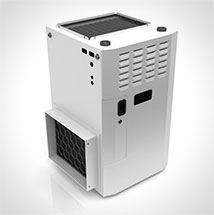Services
Furnaces

What's up with the cold draft in my home?
When it comes to repairing and providing maintenance for furnaces, you can rest assured that your investment will be protected when you use One Hour Heating & Air Conditioning.
A home furnace is a major appliance that is permanently installed to provide heat to an interior space through intermediary fluid movement, which may be air, steam, or hot water. The most common fuel source for modern combustion furnaces in the United States is natural gas; other common fuel sources include propane (LP), fuel oil, coal or wood. In some cases electric resistance heating is used as the source of heat, especially where the cost of electricity is low. Combustion furnaces always need to be vented to the outside. Traditionally, this is through a flue, which expels heat along with the exhaust.
Central Warm-Air Furnace: A central warm-air furnace is a type of space-heating equipment in which a central combustor or resistance unit--generally using gas, fuel oil, or electricity--provides warm air that circulates through ducts leading to the various rooms.
- A forced-air furnace is one in which a fan is used to force the air through the ducts.
- In a gravity furnace, air is circulated by gravity, relying on the natural flow of warm air up and cold air down; the warm air rises through ducts and the cold air falls through ducts that return it to the furnace to be reheated, thus completing the circulation cycle.
The furnace typically is divided into three primary components:
- The burner (includes the heat exchanger, draft inducer and venting) - The flame originates at the burners and is drawn into the heat exchanger by the negative pressure produced by the draft inducer. The hot gasses produced by the combustion of the flame pass through the chambers of the heat exchanger and heat the metal walls of the heat exchanger. The gasses cool as they transfer the heat to the heat exchanger and are at about 120 degrees as they exit on a high efficiency furnace. The cooled gasses then enter the draft inducer blower and are pushed into the venting pipes. The exhaust gasses then are directed out of the house through the vent pipes.
- The blower and air movement - The blower creates a negative pressure on the intake side which draws air into the ductwork return air system and blows the air out through the heat exchanger and then into supply air ductwork to distribute throughout the home.
- Controls and Safety Devices - The controls include a gas valve, ignition control, ignitor, flame sensor, transformer, limit control, blower control board, and flame roll out switch. A limit control is a safety device that will open the electrical circuit to the ignition control and stop the gas flow if the furnace over heats. The flame roll out switch does the same thing if the flame was rolling out of the heat exchanger instead of being completely induced into it by the draft inducer.
One Hour Heating & Air Conditioning can help you make the best decision on which furnace maintenance service or plan is best for you.
Our Difference
How do you know a company cares about the quality of their work? They stand behind it - that's how. At C&G's One Hour Heating and Air Conditioning, the warranties and guarantees are industry leading because of our experienced technicians and the high quality parts we use. Our technicians are friendly, clean, polite, drug-free and experienced--and our techniques are state-of-the-art, guaranteed!
A Family Of Home Services:
Strong partnerships and a national support system.